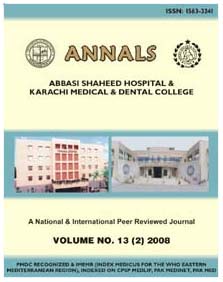
| |
| Home |
| Editorial Staff |
| Instruction to Authors |
| Journal-Issues |
| Policy |
| Copyright |
| ESBL(EXTENDED SPECTRUM BETA-LACTAMASES) AND
NON-ESBL ISOLATES IN URINARY TRACT INFECTION
*MUGHIS UDDIN AHMED, **NADIA AL-HAWASHIM ***MOTASIM AHMED, ****NEARCHOS YIANNAKOU ABSTRACT Objective:To determine the prevalence of Extended Spectrum Beta-Lactamase (ESBL) among Enterobacteriaceae isolated from urine culture in a tertiary care hospital and comparing it with Non-ESBL. The organisms identified were Escherichia coli, Klebsiella pneumoniae, Klebsiella oxytocia and Proteus mirabilis in ESBL as well as in the control group. Materials and Methods: We carried out this study at the King Abdul Aziz National Guard Hospital Al-Ahsa, Kingdom of Saudi Arabia during the period from January 2006 to August 2008. We tested a total of 1522 isolates of the family Enterobacteriaceae from urine culture for the prevalence of Extended Spectrum Beta-Lactamase (ESBL) and Non-ESBL production by the standardized disc diffusion method and confirmed by the ESBL E-test strips. All cases of Urinary Tract Infection (UTI) irrespective of age, sex, color, race, cast and creed were included in this study. Single isolates were included in this study. Four organisms for which initial screening as well as confirmatory facilities were present (Escherichia coli, Klebsiella pneumoniae, Klebsiella oxytocia and Proteus mirabilis) as well as comparable Non-ESBL. UTI with two or more organisms as isolates were excluded from this study. The patients with urinary catheters and long term care were also excluded from this study. Results: Two hundred eighty one (18.5%) of the isolates out of 1522 were ESBL producers and 1241(81.5%) were Non-ESBL producers. The ratio between ESBL and Non-ESBL was 1:4.4. Among these ESBL, 207(73.7%) were Escherichia coli, 67(23.8%) were Klebsiella pneumoniae followed by 6(2.1%) Proteus mirabilis and 1(0.4%) Klebsiella oxytocia. In Non-ESBL producer isolates there were 886(71.4%) Escherichia coli, 309(24.9%) Klebsiella pneumoniae, 42 (3.4%) Proteus mirabilis and 4(0.3%) Klebsiella oxytocia. The ESBLs were 100% sensitive to Imipenam and Meropenam. The penicillin's, cephalosporin's and aztreonams were 100% resistant against ESBL. Conclusion: Escherichia coli, Klebsiella pneumoniae, Proteus mirabilis and Klebsiella oxytocia that produced ESBL were present in quite a high number. Extended Spectrum Beta-Lactamase gram-negative bacilli present significant diagnostic and therapeutic challenges to the management of infections due to these organisms. Microbiology laboratories should start reporting ESBL producing Enterobacteriaceae isolates due to their importance in respect to antibiotic therapy and infection control aspects.
|
For Full text contact to:
|
|
* Consultant Microbiologist
|

Copyright © 2009 Abbbas Shaheed Hospital and Karachi Medical & Dental College.
All rights reserved.
Designed & Developed by: Creative Designers